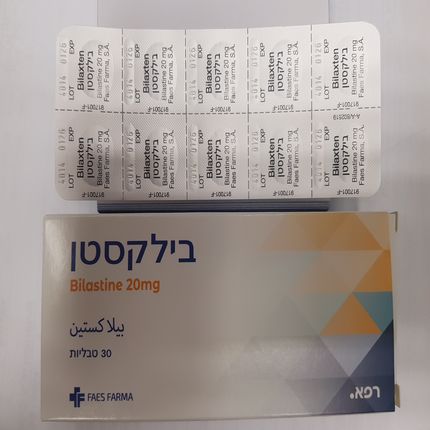Quest for the right Drug

בילקסטן BILAXTEN (BILASTINE)
תרופה במרשם
תרופה בסל
נרקוטיקה
ציטוטוקסיקה
צורת מתן:
פומי : PER OS
צורת מינון:
טבליה : TABLETS
עלון לרופא
מינוניםPosology התוויות
Indications תופעות לוואי
Adverse reactions התוויות נגד
Contraindications אינטראקציות
Interactions מינון יתר
Overdose הריון/הנקה
Pregnancy & Lactation אוכלוסיות מיוחדות
Special populations תכונות פרמקולוגיות
Pharmacological properties מידע רוקחי
Pharmaceutical particulars אזהרת שימוש
Special Warning עלון לרופא
Physicians Leaflet
Adverse reactions : תופעות לוואי
4.8 Undesirable effects Summary of safety profile in adult and adolescent patients The incidence of adverse events in adult and adolescent patients suffering from allergic rhinoconjunctivitis or chronic idiopathic urticaria treated with 20 mg bilastine in clinical trials was comparable with the incidence in patients receiving placebo (12.7% versus 12.8%). The phase II and III clinical trials performed during the clinical development included 2525 adult and adolescent patients treated with different doses of bilastine, of which 1697 received bilastine 20 mg. In these trials 1362 patients received placebo. The ADRs most commonly reported by patients receiving 20 mg bilastine for the indication of allergic rhinoconjunctivitis or chronic idiopathic urticaria were headache, somnolence, dizziness, and fatigue. These adverse events occurred with a comparable frequency in patients receiving placebo. Tabulated summary of adverse reactions in adult and adolescent patients ADRs at least possibly related to bilastine and reported in more than 0.1% of the patients receiving 20 mg bilastine during the clinical development (N = 1697) are tabulated below. Frequencies are assigned as follows: Very common (≥1/10) Common (≥1/100 to <1/10) Uncommon (≥1/1,000 to <1/100) Rare (≥1/10,000 to <1/1,000) Very rare (<1/10,000) Not known (cannot be estimated from the available data) Rare, very rare and reactions with unknown frequency have not been included in the table. Bilastine All Bilastine Placebo System Organ Class 20 mg Doses N = 1362 Frequency Adverse reaction N=1697 N=2525 Infections and infestations Uncommon Oral herpes 2 (0.12%) 2 (0.08%) 0 (0.0%) Metabolism and nutrition disorders Uncommon Increased appetite 10 (0.59%) 11 (0.44%) 7 (0.51%) Psychiatric disorders Uncommon Anxiety 6 (0.35%) 8 (0.32%) 0 (0.0%) Insomnia 2 (0.12%) 4 (0.16%) 0 (0.0%) Nervous system disorders Somnolence 52 (3.06%) 82 (3.25%) 39 (2.86%) Common Headache 68 (4.01%) 90 (3.56%) 46 (3.38%) Uncommon Dizziness 14 (0.83%) 23 (0.91%) 8 (0.59%) Ear and labyrinth disorders Uncommon Tinnitus 2 (0.12%) 2 (0.08%) 0 (0.0%) Vertigo 3 (0.18%) 3 (0.12%) 0 (0.0%) Cardiac disorders Uncommon Right bundle branch block 4 (0.24%) 5 (0.20%) 3 (0.22%) Sinus arrhythmia 5 (0.30%) 5 (0.20%) 1 (0.07%) Electrocardiogram QT 9 (0.53%) 10 (0.40%) 5 (0.37%) prolonged Other ECG abnormalities 7 (0.41%) 11 (0.44%) 2 (0.15%) Respiratory, thoracic and mediastinal disorders Bilastine All Bilastine Placebo System Organ Class 20 mg Doses N = 1362 Frequency Adverse reaction N=1697 N=2525 Uncommon Dyspnoea 2 (0.12%) 2 (0.08%) 0 (0.0%) Nasal discomfort 2 (0.12%) 2 (0.08%) 0 (0.0%) Nasal dryness 3 (0.18%) 6 (0.24%) 4 (0.29%) Gastrointestinal disorders Uncommon Upper abdominal pain 11 (0.65%) 14 (0.55%) 6 (0.44%) Abdominal pain 5 (0.30%) 5 (0.20%) 4 (0.29%) Nausea 7 (0.41%) 10 (0.40%) 14 (1.03%) Stomach discomfort 3 (0.18%) 4 (0.16%) 0 (0.0%) Diarrhoea 4 (0.24%) 6 (0.24%) 3 (0.22%) Dry mouth 2 (0.12%) 6 (0.24%) 5 (0.37%) Dyspepsia 2 (0.12%) 4 (0.16%) 4 (0.29%) Gastritis 4 (0.24%) 4 (0.16%) 0 (0.0%) Skin and subcutaneous tissue disorders Uncommon Pruritus 2 (0.12%) 4 (0.16%) 2 (0.15%) General disorders and administration site conditions Uncommon Fatigue 14 (0.83%) 19 (0.75%) 18 (1.32%) Thirst 3 (0.18%) 4 (0.16%) 1 (0.07%) Improved pre-existing 1 (0.07%) 2 (0.12%) 2 (0.08%) condition Pyrexia 2 (0.12%) 3 (0.12%) 1 (0.07%) Asthenia 3 (0.18%) 4 (0.16%) 5 (0.37%) Investigations Uncommon Increased gamma- 2 (0.15%) 7 (0.41%) 8 (0.32%) glutamyltransferase Alanine aminotransferase 3 (0.22%) 5 (0.30%) 5 (0.20%) increased Aspartate aminotransferase 3 (0.22%) 3 (0.18%) 3 (0.12%) increased Blood creatinine increased 2 (0.12%) 2 (0.08%) 0 (0.0%) Blood triglicerides 2 (0.12%) 2 (0.08%) 3 (0.22%) increased Increased weight 8 (0.47%) 12 (0.48%) 2 (0.15%) Frequency not known (cannot be estimated from the available data): Palpitations, tachycardia, hypersensitivity reactions (such as anaphylaxis, angioedema, dyspnoea, rash, localised oedema/local swelling, and erythema), and vomiting have been observed during the post-marketing period. Description of selected adverse reactions in adult and adolescent patients Somnolence, headache, dizziness and fatigue were observed either in patients treated with bilastine 20 mg or with placebo. The frequency reported was 3.06 % vs. 2.86% for somnolence; 4.01% vs. 3.38% for headache; 0.83% vs. 0.59% for dizziness, and 0.83% vs. 1.32% for fatigue. The information collected during the post-marketing surveillance has confirmed the safety profile observed during the clinical development. Paediatric population During the clinical development the frequency, type and severity of adverse reactions in adolescents (12 years to 17 years) were the same as observed in adults. The information collected in this population (adolescents) during the post-marketing surveillance has confirmed clinical trial findings. Reporting of suspected adverse reactions Reporting suspected adverse reactions after authorisation of the medicinal product is important. It allows continued monitoring of the benefit/risk balance of the medicinal product. Any suspected adverse events should be reported to the Ministry of Health according to the National Regulation by using an online form https://sideeffects.health.gov.il/

שימוש לפי פנקס קופ''ח כללית 1994
לא צוין
תאריך הכללה מקורי בסל
לא צוין
הגבלות
לא צוין
מידע נוסף
